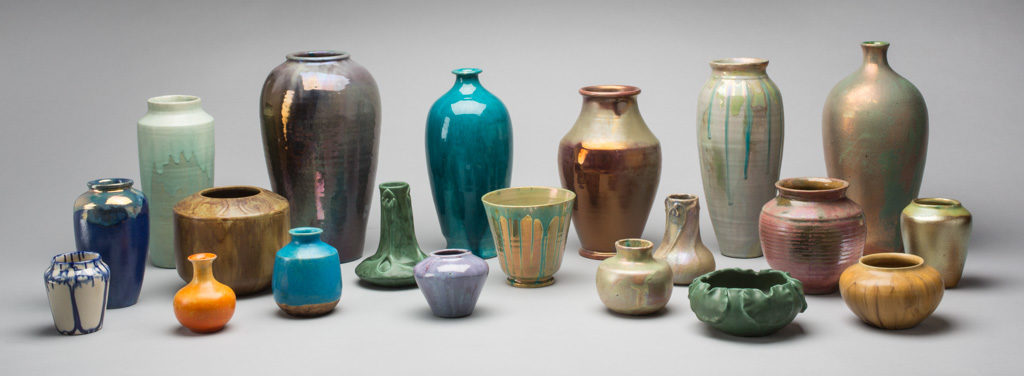
Santa came a little early last week when I had the opportunity to preview the encyclopedic exhibition of Pewabic Pottery opening Saturday at Cranbrook. One of the largest private collections in the nation, “Simple Forms, Stunning Glazes” features the 117-piece collection of Gerald W. McNeely, recently donated to Cranbrook by the New York-based collector. I toured the luminous exhibition with director of the Center for Collections and Research’s Gregory Wittkopp and collections fellow Stefanie Dlugosz-Acton, who curated the exhibition. Both shared their thoughts about the collection and exhibition with Trash or Treasure readers.
Who is Gerald McNeely? Why did he collect Pewabic?
GW: Gerald McNeely lives in New York City, where he studied painting and drawing at the Cooper Union, developed a career working as a graphic designer and commercial illustrator, and socialized in a circle of artists that included Andy Warhol. Although he considers himself a New Yorker, he was born in Michigan and raised in Detroit, where he studied fine arts at the legendary Cass Technical High School. It was also in Detroit as a young student at Trombley Elementary School that he had his first exposure to Pewabic Pottery, creating an ashtray with a turquoise glaze that was fired at the pottery as a gift for his father. This experience, coupled with memories of the pottery’s work on display in the Detroit Institute of Arts, led to a lifelong passion that ultimately resulted in his creation of one of the largest private collections of Pewabic Pottery. Now retired, McNeely explored several museums as homes for the 117 works in his collection, choosing Cranbrook, in part, because of its 100 year association with Pewabic Pottery. He’s still living in New York and will be here for the opening.
How did the collection end up at Cranbrook?
GW: In 2011 I was approached by someone helping his friend find an appropriate museum for McNeely’s collection. He had collected since the 1970s but had started to think about his legacy and wondering if his heirs would appreciate the collection and keep it together…he felt it had to be somewhere in Pewabic’s backyard. We have worked very closely with Pewabic on this exhibition and are doing a lot of joint programming. It’s a very collaborative exhibition.How does Pewabic fit the Cranbrook experience/vision?SD: There is a long shared history. Booth and Stratton were very close friends…during their lifetime, the Booths were enthusiastic supporters of Perry Stratton and Pewabic Pottery. Their purchases were intended as gifts and for display in their home. Many of the works were placed all over the Cranbrook community …we have many receipts in the collection for works Booth bought from Pewabic, including five fireplaces commissioned in 1907 for $125, which was quite cheap at the time They had so many things in common… just about every Cranbrook building after about 1925 has some Pewabic.
What are the highlights?
GW: Many of these pieces have never been seen by the public and the exhibition spans Stratton’s lifetime of making ceramics. The range in the show is incredible as far as forms and glazes. People ask why 117 pieces? Why not just 30 or so? We really felt the significance of the collection is in its entirety. It shows all aspects of the pottery, essentially every glaze they worked on is represented. It’s the inventory of forms and glazes that makes it the definitive study collection.
SD: There are some really rare pieces, including a Revelation kiln piece from 1901-1903 that predates the founding of the pottery. The blue-and-white piece has a painted underglaze and is more traditional arts and crafts pottery; you wouldn’t know by looking at it that it’s Pewabic. Another highlight is the small snowdrop base, one of four remaining with the early metallic luster (Ed Note: a reproduction will be sold in honor of the exhibition). It’s unmarked. Another is the large 14-inch piece with the glaze that McNeely called “Spider web.” It’s the tallest one in the collection at 14 inches and dates to about 1910.
What sets this collection apart?
GW: Other local museums have stunning works in their collection, but you’re only seeing a part of the story there. You can see the whole story here.
The exhibition is on view through Aug. 28. Cranbrook Art Museum is at 39221 Woodward Ave., on the campus of Cranbrook Educational Community in Bloomfield Hills. For more information phone 248 645.3323 or visit cranbrook.edu.
Also, collaborative programming is planned at Cranbrook and Pewabic, where executive director Steve McBride praised the show as “a wonderful showcase of the glaze magic Pewabic is renowned for. It’s an exciting look back at some of our early work, and highlights the close relationship Pewabic has long shared with Cranbrook.” Upcoming events include tours of Cranbrook’s pottery and an exhibition catalog book launch in February, and a separate exhibition opening at Pewabic in January that is being curated by Anders Ruhwald.
Source: The Detroit News
Media Inquiries:
Julie Fracker
Director of Communications
Cranbrook Academy of Art and Art Museum
248.645.3329
jfracker@cranbrook.edu.

Copyright © 2025 Cranbrook Art Museum. All rights reserved. Created by Media Genesis.